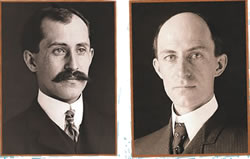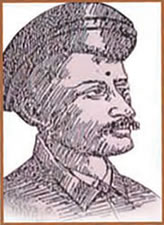
Dimdima
Online Children's Magazine from India

Dimdima
Online Children's Magazine from India

Orville Wright has gone down in history as the first man to fly an aeroplane that had been fitted with an engine and could be controlled in flight. He accomplished this feat on 17 December 1903 with the help of his brother Wilbur. Orville and Wilbur Wright were bicyclemakers who together built the aeroplane, which they named ‘Flyer’.
But was Orville really the first to take wing?
Support is building up for the view that the first man to take an aeroplane into the skies was a German settler in the USA, Gustav Albin Weisskopf who later changed
his name to Gustave Albin Whitehead. He reportedly successfully flew an aircraft that he had built, in August 1901 and then again in 1902.
 Amazingly, in 1895, eight years before the Wright brothers became airborne, a Sanskrit teacher and aviation enthusiast in Maharashtra, Shivkar Bapuji Talpade displayed an aircraft he had built, on the sands of Mumbai’s Chowpatty beach. According to a student of Talpade, S.D. Satwelkar, the unmanned aircraft ‘Marutsakha’, took off and remained airborne for some minutes before falling down to earth. There’s no reliable eyewitness account of the flight nor did the city’s newspapers report the flight of a heavier-than-air machine, an achievement that would have made front page news. So in all probability the flight never happened. We are told that Talpade’s relatives sold the aircraft as scrap to try to recover some of the money he had sunk into the project; some say he tried to get funding for further research in aviation but without success.
Amazingly, in 1895, eight years before the Wright brothers became airborne, a Sanskrit teacher and aviation enthusiast in Maharashtra, Shivkar Bapuji Talpade displayed an aircraft he had built, on the sands of Mumbai’s Chowpatty beach. According to a student of Talpade, S.D. Satwelkar, the unmanned aircraft ‘Marutsakha’, took off and remained airborne for some minutes before falling down to earth. There’s no reliable eyewitness account of the flight nor did the city’s newspapers report the flight of a heavier-than-air machine, an achievement that would have made front page news. So in all probability the flight never happened. We are told that Talpade’s relatives sold the aircraft as scrap to try to recover some of the money he had sunk into the project; some say he tried to get funding for further research in aviation but without success.
He died in obscurity in 1916.
EXPLORE MORE...
Get Help or Give Help.
- Do you have a Science Question?
- Post it here and get the answer.
- Some questions posted by others are not yet answered.
- View those questions and answer them.
Dimdima is the Sanskrit word for ‘drumbeat’. In olden days, victory in battle was heralded by the beat of drums or any important news to be conveyed to the people used to be accompanied with drumbeats.
Bharatiya Vidya Bhavan
K. M Munshi Marg,
Chowpatty, Mumbai - 400 007
email : editor@dimdima.com
Bharatiya Vidya Bhavan
505, Sane Guruji Marg,
Tardeo, Mumbai - 400 034
email : promo@dimdima.com
Dimdima.com, the Children's Website of Bharatiya Vidya Bhavan launched in 2000 and came out with a Printed version of Dimdima Magazine in 2004. At present the Printed Version have more than 35,000 subscribers from India and Abroad.